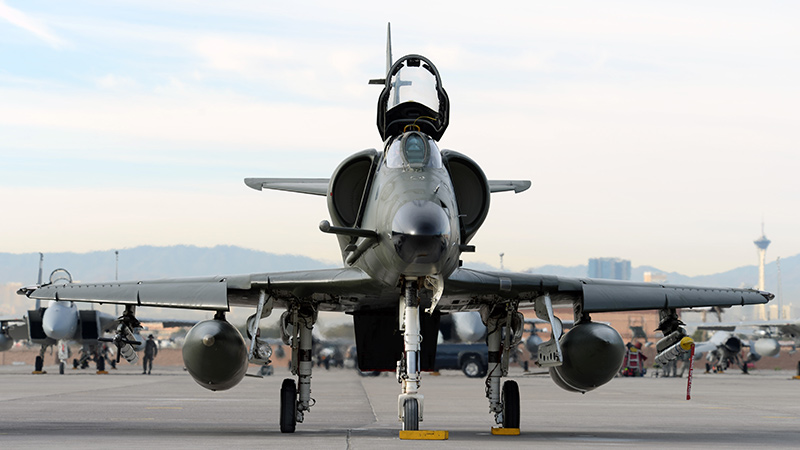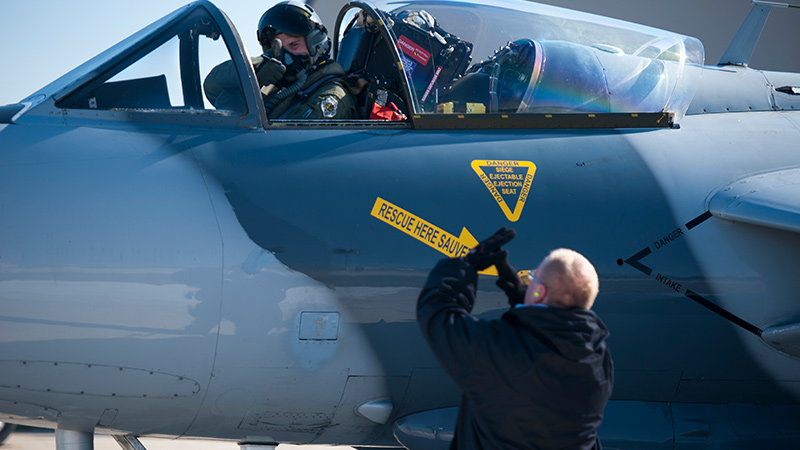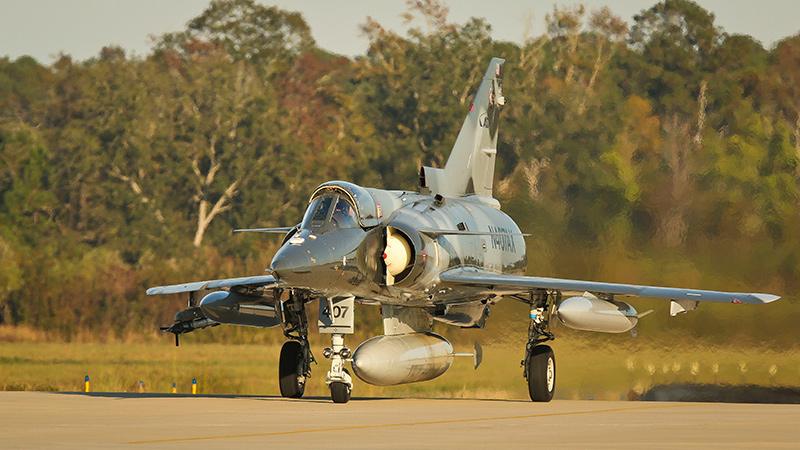Stay Up to Date
Submit your email address to receive the latest industry and Aerospace America news.
U.S. Air Force is preparing to outsource much of its demand for "aggressor" aircraft to private companies
When Air Force Lt. Col. Kevin “Flash” Gordon retired from the service two years ago, he walked across the ramp at Nellis Air Force Base in Nevada and joined the Nellis arm of Draken International. The Florida-based company is among a cadre of firms that specialize in equipping and piloting retired fighter planes to mimic the aircraft that U.S. fighter pilots would face in combat against the likes of China or Russia.
Historically, the role of aggressor, or Red Air forces, has been played by active duty Air Force, Navy and Marine Corps squadrons. Gordon used to lead one of those squadrons, specifically the F-16C-equipped 64th Aggressor Squadron at Nellis. He now flies Draken-owned Douglas A-4K Skyhawks and Aerovodochy L-159Es against student pilots at Nellis, which is home to the Air Force Weapons School.
Gordon’s new job is emblematic of a shift by commanders toward acceptance of contract adversary services, though sometimes with reservations. Depending on who is speaking, the trend is either an economically driven temporary step or a permanent step toward better training. At stake is just how far the contract adversary industry will grow, and how best to plug the widely observed shortage of adversary aircraft to properly train fighter pilots in the U.S.
“This is a massive opportunity and a huge challenge for our industry says Draken International CEO Jared Isaacman. “We have to deliver quantity and capability while remaining affordable with airplanes modernized appropriately to achieve the perfect balance for the customer.”
These days at Nellis, Red Air sorties are created by mixing privately owned and flown aggressor planes with F-16s flown by Gordon’s former squadron. Fresh out of the cockpit of an L-159 in late November, Gordon described what it’s like to fly in a force made up of A-4s, L-159s and F-16s.
He and his Red Air colleagues were simulating twin-engine Sukhoi SU-30 Mk.2 multirole fighters, a type flown by the Chinese Navy. They carried simulated air-to-air missiles and air-to-ground bombs. On the Blue, or friendly side, trainees flew F-16s, F-15Cs, F-22s and F-35s, and were tasked with defending targets for 50 minutes.
“We were fighting air-to-air and if we got to the target we were dropping bombs,” Gordon says. “I had a kill on a Blue guy and another L-159 killed a Blue guy,” he adds. “It would be good if none of us ever got a kill, but I’d rather these guys learn from their mistakes here than, god forbid, on a real mission.”
Gordon’s snapshot illustrates how contractors are now starting to take over a role the military once largely handled alone.
Big dollars
Over the last three decades the U.S. military has closed down most of its aggressor squadrons, devoting dwindling funding to operational aviation units rather than supporting adversary training. Today, two dedicated aggressor squadrons remain in the Air Force, three in the Navy, and one in the Marine Corps. That’s roughly a third of the active duty units that flew in the aggressor role as recently as the late 1980s.
In the mid-1990s, contract adversary firms began to form to fill part of the void, offering commercially owned tactical jet aircraft flown by civilian pilots to provide a range of Red Air training. For two decades, military demand for outsourced Red Air remained relatively modest.
That changed dramatically last July when the Air Force released a draft solicitation outlining demand for nearly 40,000 hours of adversary air services annually at 12 bases, including 11,250 hours per year at the Nellis school. This Adversary Air, or ADAIR, business could be worth $400 million spread among multiple companies.
Draken will be among the companies bidding for this work, with awards scheduled to begin in 2019. The U.S Navy is also planning to make greater use of contract adversary support with its own solicitation due midway through 2018.
Highly motivated
To understand the changes and challenges of this contracting trend, I spoke with Air Force officials and three of the major players in contract adversary support, Draken; Airborne Tactical Advantage Company, or ATAC, based in Virginia; and Tactical Air Support Inc., or TacAir, headquartered in Nevada.
What is driving the trend? “We have a decrease in readiness and a fighter pilot shortage,” says John Saghera, Air Combat Command’s ADAIR Functional Lead. “Contract adversary support is the quickest and most cost effective means to get us bridged to where we can build the Air Force back up to where we can maintain organic aggressor status.”
Saghera’s comments reflect those of the military’s top commanders. In 2017 testimony before the House and Senate Armed Services committees, service chiefs said that a shortage of funding, personnel and equipment has led to a military-wide readiness problem.
The Air Force vice chief of staff, Gen. Stephen Wilson, told the committees the Air Force was “out of balance,” adding that “this nonstop combat, paired with budget instability and lower-than-planned top lines made the United States Air Force one of the smallest, oldest-equipped, and least-ready in our history.”
An improving economy has also led to an exodus of pilots across the services, often to lucrative careers in commercial aviation “1,500 pilots short and, if we don’t find a way to turn this around, our ability to defend the nation is compromised,” said Gen. David Goldfein, Air Force chief of staff, speaking in September at an Aircrew Summit at Joint Base Andrews outside Washington, D.C.
Recognizing the problem, President Donald Trump in October signed an executive order that would allow the military services to recall retired military pilots to active duty.
Now a military analyst, retired Marine Corps Lt. Col. David Berke flew F/A-18 Hornets in combat, the F-22 Raptor for the Air Force, and the F-35B for the Marines as commander of the fighter’s first operational training squadron, from 2012 to 2014. He was also a Navy Top Gun lead adversary instructor. Now a nonresident senior fellow with the Center for Strategic & Budgetary Assessments, he says the military’s lack of adversary training resources amounts to a Red Air crisis and views the adoption of contract adversary support as a positive development.
“It would be catastrophic if our Air Force, Navy and Marine aviators lost the ability to train against Red Air. What the adversary squadrons have provided historically and what contract adversary support firms can offer is absolutely invaluable from a readiness standpoint. Without Red Air we would be woefully unprepared for future warfare.”
While the Navy has availed itself of contract adversary support for nearly two decades, the Air Force has been a reluctant and sparing user.
According to the commander of Air Combat Command in Virginia, the ADAIR contract will turn the service into a consumer, but temporarily.
“In a perfect world we would have the resources to maintain the aggressor squadrons that we used to have, and we’d do our best to work in-house,” said Air Force Gen. Mike Holmes, during the annual Air, Space and Cyber conference in September near Washington, D.C.
“In the world we’re living in now, I don’t want to have to trade an actual fighter squadron for an aggressor squadron because of limits on my budget,” he adds. “The next best thing is to see if we can contract some of that Red Air out.”
Hiring bandits
With the two organic adversary units left — the 64th Aggressor Squadron at Nellis and the 18th Aggressor Squadron at Eielson Air Force Base, Alaska — the Air Force is thousands of flight hours short of the training it requires for current aviators. In addition, the service must train hundreds of F-35 Joint Strike Fighter pilots as more of the fifth-generation fighters enter operational service over the next decade.
Recognizing its predicament, the Air Force commissioned a feasibility study of contract adversary support in 2014. It also awarded a one-year contract to Draken International in late 2015 to evaluate the real world performance of a commercial Red Air provider. The Air Force thought the trial went well and the service extended its contract with Draken through 2018.
That arrangement addresses short-term requirements. The ADAIR contract will run for a decade with the possibility of an extension.
With the multiaward contract set to commence in about 18 months, contract adversary providers are scrambling to procure the people and equipment necessary to bid for the lucrative work. They’re also conversing with the services to learn what level of capability could be required. Will contract adversaries be expected to match the sophistication of high-end aggressor planes flown by military squadrons?
The right mix
To provide the quantity of training the Air Force has asked for annually, the three company leaders I spoke with estimated that 150 to 200 aircraft will be needed. Currently ATAC, now part of Textron, operates 25 airplanes, a mix of supersonic Kfir C2s and subsonic Hawker Hunters.
Draken International actively flies 34 aircraft: 13 subsonic Douglas A-4 Skyhawks and 21 subsonic Aero Vodochody L-159 light attack jets.
TacAir has 25 supersonic Northrop F-5 fighters and a small number of subsonic Embraer A-29 Tucano trainer/light attack turboprops.
In total, these three companies offer fewer than 100 aircraft for Red Air. The number of hours the ADAIR contract calls for is just slightly less than the number of hours ATAC has flown over 20 years in the adversary business. Add in the number of hours and additional aircraft that forthcoming Navy or Marine Corps contracts will require and, as ATAC CEO Jeffrey Parker says, “it’s clear there will be plenty of business to go around.”
The prime question for these companies is how to meet requirements for the ADAIR contract and future Navy/Marine Corps contracts simultaneously. ADAIR requirements were still being defined at this writing, expected to be finalized late in 2017. As the industry understands them currently, the Air Force is looking for a range of performance for its Red Air support aircraft.
At the high end, the Air Force desires supersonic airplanes with sophisticated radar and sensors to present F-22 and F-35 trainees with near-peer challengers, replicating a variety of threats including full-fledged dogfighting. Read more about requirements.
Currently, none of the providers can simulate America’s most sophisticated adversary threats. So how will they equip themselves to represent advanced enemies?
ATAC and Draken International provided a partial answer by buying recently retired foreign fighters. In September, ATAC completed an unprecedented purchase, paying more than 30 million Euros for most of the French Air Force’s retired Dassault Mirage F1 fighter fleet, totaling 63 jets.
“It’s a huge acquisition,” Parker affirms. “And a huge quest to manage, then refurbish, upgrade and operate these aircraft and their over 6 million parts, 150 spare engines and other equipment.”
Draken International made a similar buy, purchasing 20 slightly newer Mirage F1s retired from Spanish Air Force service. In December, the company augmented its fleet further with a buy of 12 supersonic ex-South African Air Force Atlas Cheetah fighters. Both companies plan to upgrade the capabilities of these aircraft significantly but there’s uncertainty about how much capability the Air Force will ask for from industry.
Could industry airplanes play the role of fifth generation adversaries against the Air Force Blue Air?
“In the spectrum of threats, I think we’re going to train up to the 80 to 85 percent level,” Parker suggests. “And let the rest be done by 4.5 and fifth generation aircraft in the U.S arsenal as well as advanced, integrated simulator training.”
The Air Force agrees but leaves wiggle room, stating that it’s asking industry to “progressively provide advanced adversary capabilities” up to “near-peer and peer threats.”
“Tying a number to it is tough,” Air Combat Command’s Saghera says. “It’s very fluid but in general the top end is going to require in-house Air Force assets.”
Opinions differ, but leaving high-end threat simulation to government squadrons might be wisest for contract adversary providers. Draken’s Issacman says that the cost of simulating those advanced adversaries may not be affordable for industry.
“If you do a [Freedom of Information Act] request on what flight hour costs are for front-line combat planes, an F-16 costs about $30,000 per hour, an F-15 is about $40,000 per hour and you can imagine it goes up from there.”
“So when the ACC chief asks for $400 million for 40,000 hours, quick division gets you to around $10,000 per hour as a rough budget,” he explains. “That’s where the real challenge begins.”
Affordability is central. If the contract providers can offer training at a third to a quarter of what active duty adversaries would cost, the equation makes sense, company leaders say. This notion underpins ATAC and Draken’s acquisitions — planes that can provide performance and simulation capability approaching that of fourth generation fighter jets cost effectively.
But TacAir CEO Roland Thompson thinks that his planes can be equipped to match fourth generation capabilities. He believes his company’s F-5s, which are already familiar to the Navy and Marines, can be upgraded with electronically scanned array (AESA) radars like those in some fourth generation fighters along with other sensors. He admits this will be more costly but thinks it may be practical.
With such improvements, Thompson feels the systems on his company’s planes could be sophisticated enough to significantly challenge F-35s and F-22s. He also thinks it’s possible that the military might be open to having active duty pilots fly TacAir’s jets to gain familiarity with Red Air.
The idea of active military pilots flying contractor-supplied aircraft is a step further than the leaders of the other companies I spoke with would go. But all three executives mentioned that they are looking to procure more aircraft, including “more advanced packages.”
Perhaps there is a middle ground. “We should embrace contract Red Air,” says Berke, the analyst and retired Marine Corps pilot, “and look for all the ways it brings value but I wouldn’t support the idea of the military completely extricating itself from adversary air.”
In his view, commercial providers offer a “ridiculously good amount of really good training” with current assets that cannot be replicated in the military. Creating a truly high-end threat with contractor aircraft alone would be difficult, he cautions. However, combining commercial and military assets with sophisticated simulation and an advanced training system could work.
“We need to use the synergy of the two to create an ecosystem of threats from every domain available to train our people up to and including fifth-generation training.”
The future of Red Air
The trend is expanding globally with companies including ATAC, Draken and TacAir already providing Red Air and other training in Europe. Contracts for even more business are pending in the U.K. and other NATO countries.
Holmes, the ACC commander, has stated that contract adversary support is temporary, a gap filler until active USAF aggressor units will once again provide organic Red Air. But as ATAC’s Parker says, if the industry is successful, it will be a trend that is hard to reverse.
“I think the Navy model will persist,” he says. “Once these programs are integrated into the way of life for the USAF, Marines and Navy, that’s what they’re going to count on.”
Seeking more advanced capabilities
The U.S. Air Force told industry in December that it is considering adding “a SECRET addendum” to the unclassified request for proposals for the ADAIR (adversary air) contract, in which private companies would fly aircraft to simulate enemy aircraft during training of U.S. fighter pilots. This “notice to industry” asks companies bidding for ADAIR work to “submit a response that includes your company’s plans to obtain a SECRET facility clearance and identifies the personnel within your company holding a U.S. Government security clearance (including clearance levels).”
“We have a decrease in readiness and a fighter pilot shortage. Contract adversary support is the quickest and most cost effective means to get us bridged to where we can build the Air Force back up to where we can maintain organic aggressor status.”
John Saghera, Air Combat Command’s ADAIR Functional Lead
About Jan Tegler
Jan covers a variety of subjects, including defense, for publications internationally. He’s a frequent contributor to Defense Media Network/Faircount Media Group and is the author of the book “B-47 Stratojet: Boeing’s Brilliant Bomber,” as well as a general aviation pilot.
Related Posts
Stay Up to Date
Submit your email address to receive the latest industry and Aerospace America news.







